2007 Interbike Preview
Every year Interbike just plops itself on my September, like a ladle-full of mashed potatoes. It arrives out of context. The season’s not over yet. We haven’t contested Ironman, or the 70.3 championships. I can’t think about next year’s products yet.
It’s not that I don’t like it. It’s that I don’t like it in September. That show invades my season’s twilight like a snoopy, close-talking neighbor who visits just before my bedtime. The idea is good, but the backdrop is wrong, like a western shot on a set used for film noir.
So, I decided to give Interbike my own backdrop. Instead of Interbike sneaking up on me, I decided to sneak up on it. And now I’m ready to pounce. Consider this article my pounce.
I did not write this for you, unless you’re a retailer. I wrote it for the 250 or so brick & mortar stores in North America that ought to matter to triathletes. If you are a retailer, and you’re reading this, I’m your advance man. I’ve done the research. If you’re a consumer, you helped in my research. Every time you clicked a box telling me what you intend to buy next, you were “n” equals yet another data point. Thank you.
And because of the part you played in this, I’m letting you in on what I would normally say only to the industry. I’m writing to the industry because Interbike sneaks up on them, too. Just when you’re ready to exhale and count your money and see whether you put any in your pocket this year, you’ve got to negotiate a maze of 900-plus booths, not to ferret out the good products and good values, but to divine what next year’s end user will think is good product and good value.
So, here’s what to look for, and we’ll go through this a category at a time. Certainly there will be a lot at Interbike that we’re not covering with this overview. That’s why you have to go, and that’s why we’re going, and we’ll report from Interbike live. But you have to go with a game plan, and we hope what we write below will help you strategize yours.
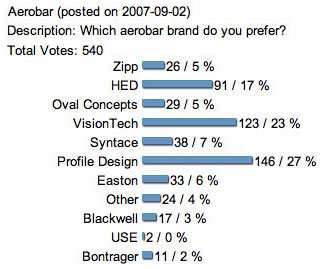
AEROBARS
Profile Design may not be the sexiest name in aerobars. It’s just the biggest name, and it’s better to be big than sexy. Furthermore, it’s going to remain that way, according to our reader poll with 540 respondents. Here’s the thing about Profile: a retailer needs its bars, because a lot of today’s tri bikes are built with bars with low-profile armrests. QR’s bikes are an example. Lots of these bikes will have to be refitted with higher profile armrests, unless a string of spacers is okay with you.
Visiontech is in second place, not far behind. And retailers need to stock this bar for the opposite reason. Tri bikes with large head tubes, like Scott and Cannondale, will have to have a lot of those tall armrest Profiles pulled off in favor of the low-slung Visiontechs.
What’s surprising is HED in third place. At 17 percent popularity, especially for a product line of this expense, this company’s popularity as a handlebar maker rivals or exceeds its status as a first line wheel maker.
No other company gets more than 7 percent worth of respect.
RETAILER ACTION: Amble over to Oval Concepts and look at its shorty bar. You’ll be getting requests for this.
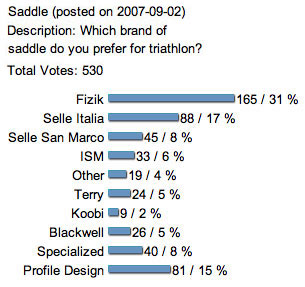
SADDLES
We asked our readers about saddles, and 519 replied that, for triathlon, Fizik is the favorite. If you haven’t seen its Arione Tri II, it’s a nice upgrade from the original Arione Tri. We ourselves did test some of Fizik’s other, more exotic and expensive, saddles, and we had spotty results. With some we had seat post compatibility problems, and some of the carbon-shelled saddles were hard. The Arione Tri II is a great saddle, and almost one out three readers agrees.
Selle Italia and Profile Design are second and third in popularity, almost in a dead heat. Profile’s TriStryke is probably the industry’s second most popular saddle, because it only makes and sells the one style. Selle Italia’s popularity is split between its SLR – a road saddle popular for tri – and its tri-specific SLR T1.
Other saddles, like those made by Blackwell and ISM Adamo, have not yet achieved wide success but have a cult following of which the enterprising retailer will take note.
RETAILER ACTION: Pay some serious attention to this category. There is no single thing you sell that’s more important to a triathlete’s riding than his saddle. If you’re the world’s best fitter, but your customer can’t sit on the selection of saddles in your store, another fitter is going to steal your customers, because he’s got them sitting on a comfy saddle. The customers won’t know that it’s the saddle that made the difference. Do not make the mistake of thinking that a good road saddle is a good tri saddle. They can be, but usually are not.
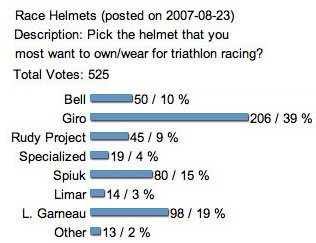
RACE HELMETS
A helmet maker, if its models are popular with triathletes, ought to count itself lucky. Only 8 responders out of 494 total said they’ll both train and race in an aero helmet. But 51 percent said they’ll train in a road helmet and race in an aero helmet, and 49 percent said they’ll do it all in a road helmet.
This means that virtually all triathletes will buy a road helmet, and half of them will buy an aero helmet as well. Another way to look at it is that any two triathletes will own and replace three helmets between them, making triathlon an arguably more profitable category of customer than any other to helmet makers.
Giro remains the favorite among manufacturers when it comes to racing, and no company in any category owns as large a market share as this one does. No doubt the Atmos, which we found in our testing to be a very comfortable helmet while in the aero position, plays a large part in Giro’s success with multisporters. The Ionos, also a road helmet, is coming soon to an Interbike near you. The Advantage2 is Giro’s popular aero helmet.
Louis Garneau runs a surprisingly strong second place, with one in five respondents choosing this brand. Maybe its association with Chris Legh has something to do with it. But it’s also likely that since this poll asked triathletes what they’ll race in, the fact that Garneau’s Rocket is one of the few aero helmets worth using pumps up its numbers.
Spiuk, Bell and Rudy Project round out the top 5. Spiuk’s strong 15 percent is certainly due to its highly regarded Kronos aero helmet. Rudy makes a nice set of aero helmets as well. Bell, with its popularity at 10 percent, is quite high considering it doesn’t feature an aero helmet in its lineup.
RETAILER ACTION: You must approach these helmets as would a triathlete. Put it on, bend over at the waist, look straight ahead, and see if the ratchet mechanism in back presses against your neck, pushing the helmet’s front down your forehead, impeding your vision. That’s going to tell you whether what you’re wearing is a good road helmet for triathletes. The Bell Sweep and Giro’s Atmos both pass this test nicely, as do other helmets. But be advised some do not. Also, with half your customer base intending to race in an aero helmet, best if you stock at least one brand of aero helmet. Not sure which one? Just go on our reader forum and search for “aero helmet,” or if you don’t want to wade through the 2,800 posts on the subject, just start a new thread and ask our readers which aero helmet you should stock.
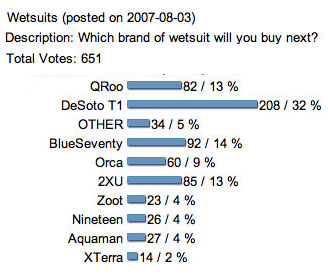
WETSUITS
For some years we at Slowtwitch thought we knew something that the rest of the triathlon world didn’t know. It turns out we were wrong. The rest of the world did know it, based on the responses of 651 people who answered our question, “Which brand of wetsuit will you buy next?”
No, it wasn’t QR, or Orca, or Blue Seventy that won, but De Soto’s T1 Wetsuit brand. And it didn’t win by a squeaker. It enjoyed about the same popularity as Cervelo does among tri bike brands. Blue Seventy, QR, and Aquaman, the three venerated tri wetsuit brands accumulated were about equal to T1 in our poll.
RETAILER ACTION: You’re going to have to hoist yourself out of your comfort zone. What is important about De Soto’s T1 is not that it’s a De Soto, it’s that it’s a two-piece wetsuit. You need to bone up on the technical elements of this suit, understand its mechanics, and why people like it and intend to buy it next. You’ll probably need to drop one of your repetitive lines in order to financially swing absorbing this new inventory. Saying no to a longtime vendor is never easy. But your ability to do this is why you haul down the big bucks 😉
There are some new products out there. Aquaman has upgraded its already fine top-end fullsuits, and 2XU seems to have gained traction quickly, equaling Blue Seventy and QR in brand interest among our readers. Zoot’s Zenith gets rave reviews from its cult following of users.
Then there’s the business angle. Orca’s decision to grant its distribution to Orbea is intriguing. If you’re an Orbea dealer, you might inquire as to what financial elements accrue to carrying both lines. At QR, we used to allow product to be sent back for credit against any other product we made, with no restocking fee. You could swap bikes for wetsuits, and vice versa, as long as you were current on your bill and it was current year product. Also, it was the total dollar volume that generated better margins and terms, as is the case with Trek’s programs. Maybe it’ll be the same with Orca/Orbea.
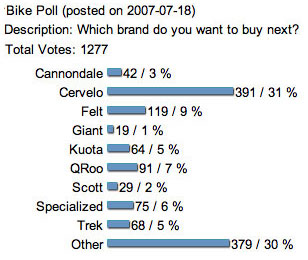
TRI BIKES
We polled three times on the subject of tri bikes. First, 1277 responders told us they’ll buy Cervelo as their next tri bike at a rate of almost one in three. No other company polled in the double digits. Felt was second, QR third, with Specialized, Trek and Kuota all following in a dead heat.
But 3 out of 10 responded that they’ll select a bike other than those from which we gave them to choose. Guru, Litespeed, Orbeea and BMC all did well in this poll. See more about Guru in our poll on custom bikes.
RETAILER ACTION: Some of you retailers out there have complained to me of Cervelo fatigue. Either you were fatigued with Cervelo’s requirement that you grow with them at their rate of growth, or you were worried about the market suffering from Cervelo saturation. Memo to you: get over it. Cervelo is like your wife: yes, there may be an element of familiarity that’s dulled the sharp edge of desire, but, like your wife, Cervelo remains more important to you than you know.

CUSTOM TRI BIKES
We polled our respondents on custom bikes because, frankly, this is a business tri bike retailers ought to be in. I write this for several reasons. First, this is where the need is. You do a lot of custom road? What’s the need there? Are these for all your customers with arms twice as long as legs? I’m not saying there’s no justification for custom road. I’m saying that whatever justification there is, double it for tri. The need is greater for custom tri than for custom road, because there are more variables in play.
The second reason is that it’s found money. It’s money you’re not making, and it slays every other category in your store using any metric you choose: return on invested dollar; return on invested time spent; return on invested floor space.
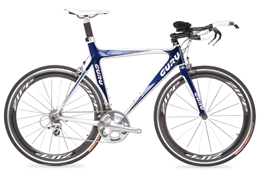
So, then, which custom line of bikes? If you’re looking at Guru (or if you are Guru, listening in), I’ve got good news and bad news. The bad news is that you can throw Guru’s robust claim of “one stop shopping” out the window. Yes, it is one stop shopping, building out of all four frame materials. But three of them are non-issues, and this leads us to the good news: Guru’s Crono. This is the bike our readers want. Let me put it this way. Guru is desired by our readers at twice the rate of the second most popular custom bike brand. But, take away the Crono, and Guru ranks no higher than fifth.
That second place maker is Elite, and this brand has a strong cult following. Also look at QR’s TiPhoon, clearly the most popular custom titanium tri frame going. Me, if I was selling custom tri bikes, I would either be a Guru dealer, or I’d look at being both a QR and an Elite dealer.
RETAILER ACTION: You can’t half-arse your way into this market. You can’t date it. You have to marry it, or you have to be satisfied to admire it from afar. If you’re going to marry it, that means a fit studio, with a top-rate position simulator, all the tools required, and all the knowledge required.
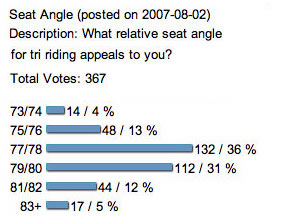
SEAT ANGLES
If I was to poll retailers across the United States, and ask them what they thought the most appropriate, most salable, seat angle is for tri bikes, I know what they’d say. I know this because I frequently poll them at my tri bike fit workshops, and they always say the same thing: 76 degrees. Then I poll them when they leave the workshop. They say 79 degrees.
With that in mind, and when one takes a look at our reader poll on the subject, it seems evident that in general the retail community is behind the curve on this. So (by the way) is much of the manufacturing community, in particular the European segment.
Two out of three of the 367 respondents choose either 77/78, or 79/80 as their favored angle. Only 13 percent chose 75/76, and in fact only 17% chose anything below 77 degrees.
RETAILER ACTION: People, it’s time to wake up and smell the coffee! There’s a reason Cervelo is so dominant! It’s because its bikes can be positioned in ways people choose to ride. Now, this doesn’t mean you position your customers aboard their Cervelos that way. Plenty of you are still placing the saddles rearward, with the stem in the plus-6-degree config and 4 centimeters of spacers under it. If this is you, your Cervelo days may be numbered. I recommend you research the ideas behind Cervelo’s geometries and drink the Cervelo koolaid.
There are intriguing bikes you’ll see at this year’s I’bike that conform to these geometries that Cervelo and QR made popular, and that our readers indicate they want. In particular take a look at the new bikes by Specialized, Cannondale, Jamis and Kuota. And I mean the new bikes. I’m not necessarily a fan of the tri bikes made by these companies in 2007, but the new Specialized S-Works, Kuota’s Kueen K, these are right in line with current thinking. This follows on the heels of last year, when Giant, Trek, Felt, and QR introduced new geometries that brought new vibrancy to their lines. These are the bike brands that bear a close look.
All that said, there are what we might call second-tier brands, and we’ll be talking about them at Interbike. We’ll report on what Javelin has done, and on brands like Beyond Fabrications, Valdora Cycles, Velo Vie, Fuji. Tune into Slowtwitch.com during I’bike and we’ll cover them all.


Start the discussion at slowtwitch.northend.network